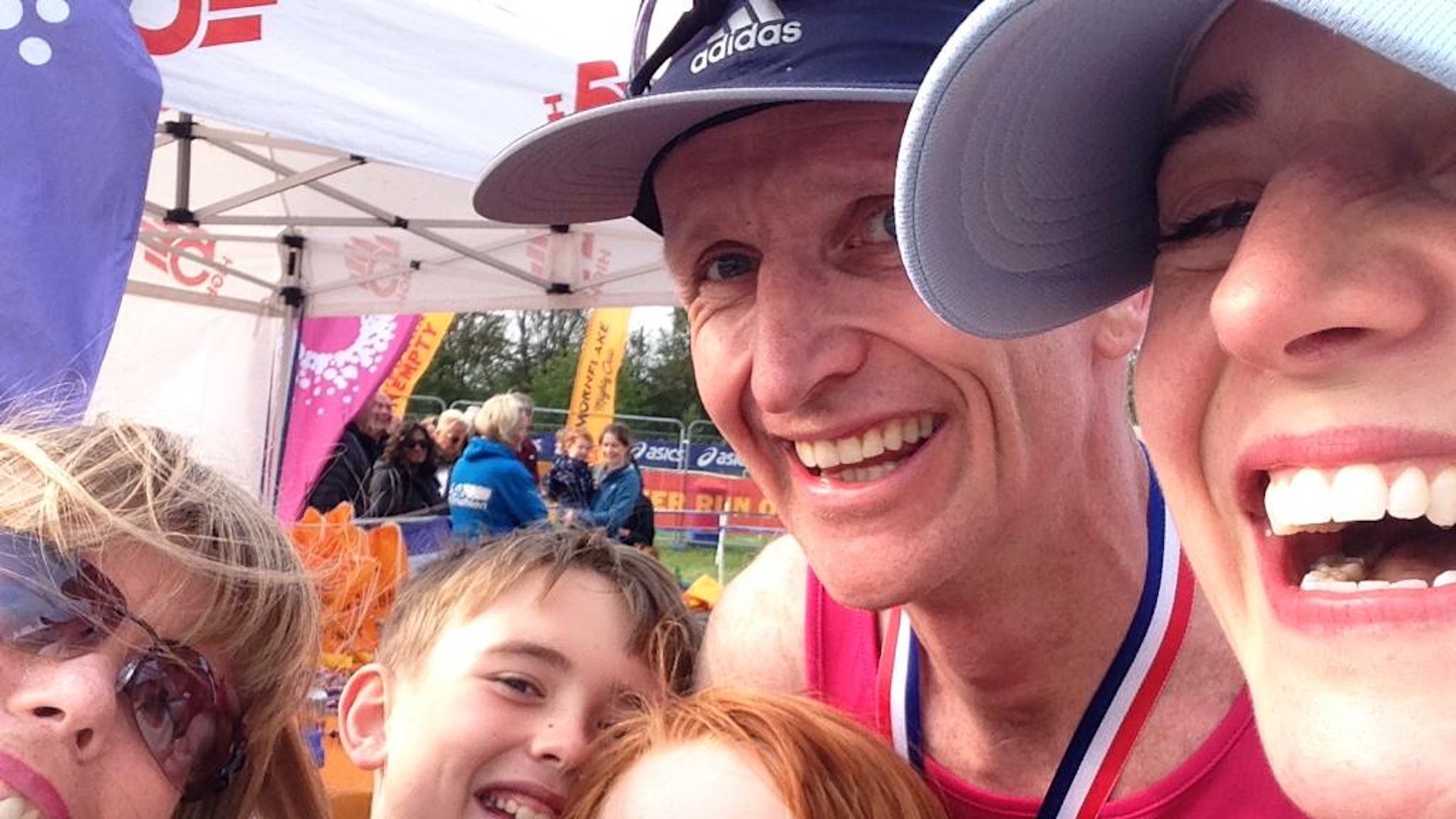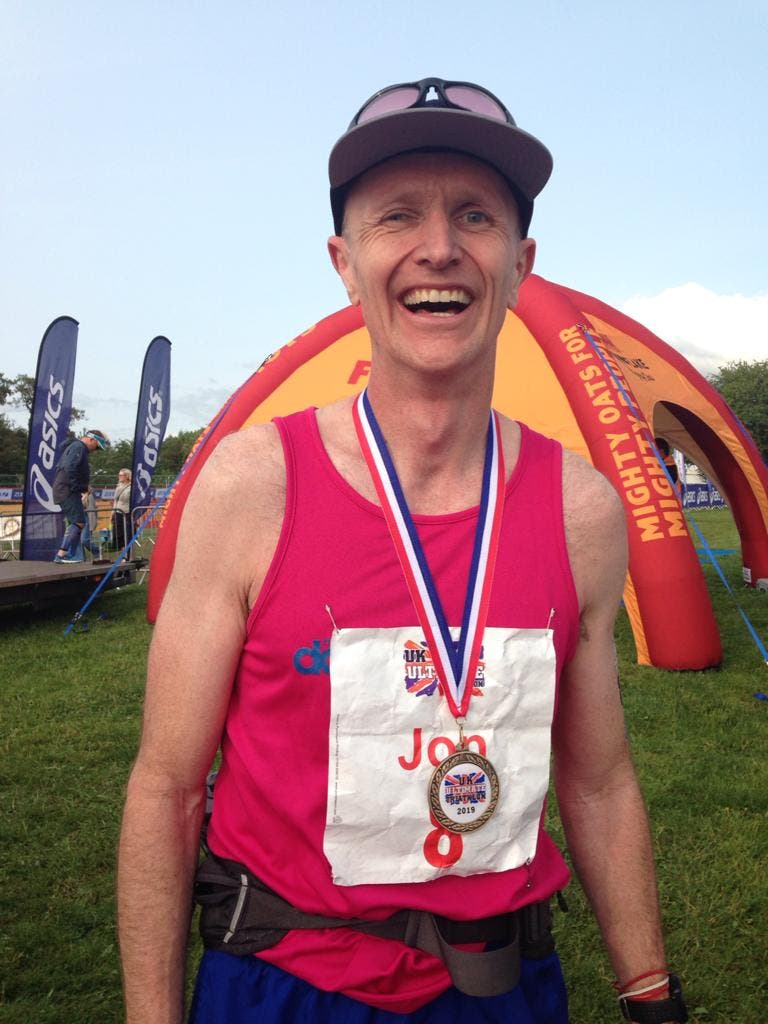#MyTri: How I Managed A Sub-11 Hour Ironman On 7 Workouts Per Week*

We’re bringing back #MyTri—where we’ll be letting triathletes tell their stories in their own words. To submit your triathlon story email letters@triathlete.com with “My Tri” in the subject line.
* There were three weeks when I did an extra swim.
On June 2, 2019, I finished my first iron-distance triathlon in a time of 10:56, finishing 10th out of 100. The race went as well as I had hoped (apart from getting lost twice on the bike course) and my training had been as minimal as possible, while still feeling prepared on the day.
Eight months prior to the Ironman, I’d run the York Marathon after following a “three runs per week” training program from Furman University. I have run seven marathons since 2001 and York was my second fastest (just under 3:02). I was convinced that a minimalist approach suited my body, which didn’t seem to like big mileage, so I resolved to try and do something similar for the Ironman. After the marathon, I took it easy in November, resumed light running and spinning in mid-December, then began training for the Ironman (i.e. started swimming again!) in mid-January.
In a nutshell, this was the Ironman program I followed: three bikes, two runs, and two swims per week—for 18 weeks. The first eight weeks were building up to being able to handle an eight-hour training week, then ten weeks of training 8 to 12 hours per week. I did no brick sessions and no speedwork or intervals. I was lucky and didn’t get sick, nor suffer any injuries.
For the bike, I used a turbo trainer twice per week for about an hour. I went off feeling rather than heart rate and kept it steady—usually three or four repeats of going up and down the gears while watching an episode of whatever box-set I was on. I didn’t do any high intensity VO2 max work, but if I felt strong, I would spend more time in the big gears. Having a fan blowing and an old towel draped over the bars as a salt-catcher were great helps. At the weekend, I swapped over the back wheel (what a party animal) and headed out on the road for a longer ride. My bike is an old Specialized Allez Sport, with slightly upgraded wheels (Mavic Aksiums), added aero bars (Profile Design T2) and the most puncture resistant tires I could find (Continental Grand Prix 4 seasons). I also saw a lovely man called Richard Salisbury for a bike fit, who adjusted my aero position and cleats, and also gave me some helpful physio home exercises. Despite having a very good bike fit—and a sustainable position as a result—I found that I still experienced discomfort in two areas after any length of time in aero: my neck/upper back and my perineum, which felt like it had been flayed with a knotted rope a la James Bond in Casino Royale. For my neck, I did the these exercises regularly (which definitely helped), and for my nether regions, I carried some Vaseline to apply mid-ride as a top-up to the excellent chamois cream I used pre-ride (Assos). If I was going to ride long in aero again now, I’d buy a cut-away saddle like an ISM or Adamo, rather than persevere with the conventionally-shaped Specialized seat.
For the run, I wanted to prioritize not getting injured, so I decided to do just two runs per week—one 10K at about marathon pace and the other a long run. I had confidence that two runs a week would be enough, as I’d run close to a marathon PB on three runs a week, and there were some “miles in the bank” from that. I ran with a small mini-metronome that kept my cadence to 90 strides per minute, which I bought after getting calf problems and reading both Chi Running and Gordon Pirie’s How to Run Fast and Injury-Free. I thought the beep might get on my nerves but I actually liked it, in contrast to other people who seemed to go through the following stages: wondering what the strange noise was; feeling momentarily confused and alarmed; then being annoyed that someone had made them feel that way – before finally re-arranging their face to hide their annoyance. The long run was usually Sunday, though I would sometimes choose to run in the rain on a Saturday, so I could bike in the dry the day after.
Swim-wise, I mostly “just swam,” but also did some lengths with a pull buoy/ankle strap and Speedo finger paddles—but no kicking drills. I had given bi-lateral breathing a good try previously—two 30-minute sessions of gargling chlorine—before deciding it was not for me. What made me a faster swimmer, apart from practice, was realizing what my arm had to do when under water, aka the pull phase, which is shown here. Once I realized this—keeping my arm close to an L-shape, with the forearm and hand flat as a paddle while engaging my lats—I felt like I could really swim. I’d done a half-Ironman swim in 36 minutes and felt spent at the end of it, but using the above technique I did the ironman swim in 60 minutes and was fresher than after the half.
I stuck to the same number of workouts each week*, slowly increasing the long run, long ride, and long swim, with an easier week every fourth week for recovery. By late March, I had built up the long bike to 2.5 hours, long run to a half-marathon, and long swim to about 2km. In the next 10 weeks, I carried on gradually increasing the distance, so that by the time race day came, I had completed: three bike rides of between 2.5 to 3.5 hours in length, three rides of roughly four hours, and three rides of 4:30 to 4:45—all solo, in aero, at 26-30 km/h average speed; two long runs of 13 miles, two of 15-16 miles, and four of 17-19 miles; a half-dozen 60- to 90-minute swim sessions—including 4km once—and one open water swim. My longest week was 12 hours and 10 minutes of exercise.
I wasn’t worried about the lack of brick sessions, as I’d completed a half-Ironman and Olympic tri without them. I also felt the “long” sessions were key—and I felt I’d done plenty of those to carry me through. By race day, I felt ready.

The event was the UK Ultimate Triathlon in Shropshire, which is featured in best for first-timers and best-value lists and which was just an hour away. This meant I was able to drive down the day before for briefing/bike-racking, as well as benefit from sleeping in my own bed the night before. In the end I managed just one hour’s sleep before the alarm went off, but with the adrenaline I actually didn’t feel tired at all. I gather it’s the night before the night before that is key for sleep.
Walking into the lake with AC/DC’s Thunderstruck blasting out of the speakers was a spine-tingling experience—and made the wetsuit-warming self-urination both easier and more pleasurable. With a small field there was no mad swarm at the start and the swim leg went brilliantly; four laps and I got out feeling great.
The bike course was flat, fast, and punctuated by surges of adrenaline caused by two wrong turns on laps two and four, meaning I covered an extra 3.6 miles. Despite the fact I’d not done more than 85 miles in training, the last lap of the 28-mile course didn’t feel any more onerous than the others and I finished in a time of 5:55.
The marathon was six laps of a 7km course and included some blessed rain to go with sun and humidity, as well as fantastic support. I took a liquid gel shot at each of the 12 turnaround points and allowed myself to walk while doing so, but otherwise forced myself to keep running in order to try and achieve my goal time. It worked—just—and my marathon split (3:42) was bizarrely three minutes quicker than I’d managed in a brutally hot and humid London Marathon a year earlier.
Would I do an iron-distance triathlon again? Well, unless I have a dramatic change of heart, I think I’ll stick to shorter distances. During the run, I remember looking at my fellow triathletes and thinking, “This cannot be good for us…” And the finish line euphoria after seeing my family was quickly replaced by stomach cramping and exhaustion that took a week to recover from. But! Although I couldn’t square the distance with living a sustainably healthy lifestyle, I was glad to have done it—and if it’s a goal of yours, I hope that you achieve it too.